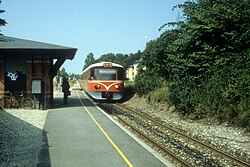Gribskov

Gribskov (Grib Forest) is Denmark's fourth largest forest, comprising c. 5,600 ha of woodland situated in northern Zealand, west and south of Lake Esrum. The forest is owned and administered by the State of Denmark, and a part of the Kongernes Nordsjælland National Park. In July 2015, it was one of three forests included in a UNESCO World Heritage Site, the Par force hunting landscape in North Zealand.Gribskov is usually divided into four sections: The northwest surrounding the small village of Maarum, the northeast on the banks of Lake Esrum, the southwest around the small lake of Gribsø and finally the southeast, enclosing the village of Nødebo on the southern banks of Lake Esrum. Only a thin strip of Hillerød town in the south separates Gribskov from many larger woodlands such as Store Dyrehave at 1,100 ha, Tokkekøb Hegn at 631 ha and several smaller woods.
Excerpt from the Wikipedia article Gribskov (License: CC BY-SA 3.0, Authors, Images).Gribskov
Ølbjerget, Hillerød Municipality
Geographical coordinates (GPS) Address Nearby Places Show on map
Geographical coordinates (GPS)
| Latitude | Longitude |
|---|---|
| N 55.983333333333 ° | E 12.3 ° |
Address
Ølbjerget
Ølbjerget
3400 Hillerød Municipality
Capital Region of Denmark, Denmark
Open on Google Maps










